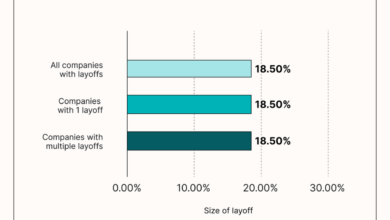
Mass General Brigham Cuts Workers
Mass General Brigham cuts workers – that headline alone sent shockwaves through the healthcare community. This isn’t just about numbers; it’s about the real people – doctors, nurses, support staff – whose lives and livelihoods are affected. We’re diving deep into the reasons behind these cuts, the financial implications for the hospital, and the very real impact on patient care.
Get ready for a look behind the curtain at a major healthcare shakeup.
The announcement of the workforce reduction at Mass General Brigham sparked immediate concern and questions. The sheer number of employees affected, coupled with the potential impact on patient care and the hospital’s long-term stability, makes this a story that demands attention. We’ll be examining the official statements, analyzing the financial factors driving this decision, and exploring the perspectives of both employees and patients.
This isn’t just a news story; it’s a human story, and we’ll be exploring all its facets.
Mass General Brigham’s Workforce Reduction
Mass General Brigham (MGB), a prominent healthcare system in Massachusetts, recently announced a significant workforce reduction, impacting hundreds of employees. The news, while expected by some given the current economic climate and pressures facing the healthcare industry, has understandably caused concern and uncertainty among staff and the wider community. This post aims to summarize the official announcement and analyze the details provided.
The Official Announcement Regarding Workforce Reduction
The official statement from Mass General Brigham regarding the workforce reduction lacked specific details initially, leading to much speculation and anxiety among employees. While the exact wording varied across different internal communications, the core message consistently emphasized the need for cost-cutting measures to ensure the long-term financial stability and sustainability of the organization. The announcement highlighted the challenging economic environment and the need to adapt to evolving healthcare dynamics as key drivers for the decision.
It also emphasized a commitment to supporting affected employees through the transition process, including severance packages and outplacement services. However, the lack of transparency regarding the specific number of affected employees and departments initially fueled negative sentiment.
Specifics of the Workforce Reduction
While precise figures have not been consistently and publicly released by MGB, news reports and internal communications suggest that several hundred employees were impacted by the job cuts. The departments affected spanned various areas, including administrative support, non-clinical roles, and potentially some clinical support roles. Reports indicate that the cuts were not uniformly distributed across all departments, with some areas experiencing more significant reductions than others.
The lack of complete transparency makes a precise accounting difficult, and official figures remain elusive to the public.
Reasons Cited for the Job Cuts
The official reasons cited for the job cuts primarily revolved around financial pressures and the need for organizational restructuring. MGB highlighted challenges in managing rising costs, particularly in the face of reduced reimbursement rates from insurers and government programs. The need to streamline operations and improve efficiency was also frequently mentioned. The organization framed the workforce reduction as a necessary step to ensure its long-term financial health and ability to continue providing high-quality patient care.
However, some critics have argued that other cost-saving measures could have been explored before resorting to job cuts.
Impact of the Workforce Reduction
| Department | Number of Jobs Cut | Reason Cited | Projected Impact |
|---|---|---|---|
| Administrative Support | (Unspecified, but reportedly significant) | Cost reduction, streamlining operations | Potential increase in workload for remaining staff, potential delays in administrative tasks. |
| Non-Clinical Roles | (Unspecified, but reportedly significant) | Cost reduction, restructuring | Potential impact on various support services, depending on the specific roles eliminated. |
| Clinical Support Roles | (Unspecified, potentially smaller than other areas) | Efficiency improvements, potential consolidation of services | Potential impact on patient care, depending on the specific roles eliminated and the ability to reassign responsibilities. |
Financial Implications of the Cuts
Mass General Brigham’s recent workforce reduction has sent ripples through the healthcare industry, prompting crucial questions about the long-term financial health of this major institution. While the immediate goal is likely cost-saving, the complex interplay of revenue, expenses, and market positioning requires a thorough examination of the potential short-term and long-term financial consequences. The decision wasn’t made lightly, and understanding the financial context is vital to assessing its impact.The short-term impact will undoubtedly involve immediate cost savings from reduced salaries and benefits.
However, this positive effect needs to be weighed against potential negative consequences. Reduced staffing may lead to longer wait times, potentially impacting patient satisfaction and future revenue streams. There’s also the risk of decreased quality of care, which could lead to legal challenges and reputational damage, further impacting the bottom line.
Short-Term Financial Impact, Mass general brigham cuts workers
The immediate financial impact is a reduction in labor costs. This is a quantifiable benefit, and while precise figures are not publicly available, the scale of the job cuts suggests a substantial saving in the millions of dollars. However, this saving must be balanced against potential increases in other areas. For example, the hospital may need to invest in temporary staffing or overtime pay to maintain essential services, partially offsetting the initial cost reduction.
Furthermore, any negative impact on patient satisfaction or increased error rates due to staff shortages could lead to lost revenue from reduced patient volume or increased malpractice insurance premiums. A similar situation occurred at another large hospital system, where initial cost savings from layoffs were partially negated by increased overtime costs and a decline in patient satisfaction surveys.
Long-Term Financial Impact
The long-term financial impact is more difficult to predict, depending heavily on the hospital’s ability to manage the transition and maintain its reputation. If the cuts lead to a significant decline in the quality of care, it could damage the hospital’s reputation, leading to a loss of referrals and a reduction in patient volume. This would negatively affect revenue generation, potentially outweighing the initial cost savings from the layoffs.
Conversely, if the hospital effectively manages the transition and maintains a high standard of care, the long-term financial impact could be minimal or even positive, allowing for reinvestment in other areas crucial for future growth. For example, a strategic reallocation of funds could improve technological infrastructure or expand into new service areas.
Mass General Brigham’s Financial Situation Prior to the Cuts
Prior to the job cuts, Mass General Brigham, like many other healthcare providers, was facing increasing financial pressures. Rising labor costs, increasing drug prices, and a shift towards value-based care models all contributed to a challenging financial landscape. While the exact financial details are not publicly available in complete detail, reports suggest that the system was experiencing pressure on its operating margins, necessitating a strategic response to ensure long-term financial stability.
This response manifested in the difficult decision to reduce its workforce.
Comparison to Similar Healthcare Institutions
Comparing Mass General Brigham’s financial performance to similar institutions is challenging due to the lack of publicly available, granular data across all systems. However, many large hospital systems across the country are facing similar financial headwinds, leading to cost-cutting measures, including workforce reductions. The specific strategies employed vary, but the underlying pressure to control costs and maintain profitability is a common thread across the industry.
Analyzing reports from organizations like the American Hospital Association and financial statements of publicly traded healthcare companies reveals a common theme of tightening margins and the need for strategic cost management across the sector.
Impact on Patient Care

Source: massgeneralbrigham.org
The recent workforce reductions at Mass General Brigham (MGB) raise serious concerns about the potential impact on patient care. While MGB has stated its commitment to maintaining high-quality care, the sheer scale of the job cuts necessitates a careful examination of the potential consequences for patients across various demographics and care settings. The potential ripple effects extend beyond simple staffing shortages and could significantly affect patient access, wait times, and ultimately, safety.The most immediate concern is the potential strain on remaining staff.
Increased workloads and reduced support systems can lead to burnout, decreased morale, and potentially, medical errors. This increased burden on the existing workforce could translate directly into compromised patient care, impacting the quality and timeliness of treatment.
Patient Wait Times and Access to Care
Reduced staffing levels in areas like scheduling, admissions, and outpatient clinics are likely to lead to increased patient wait times for appointments and procedures. This could disproportionately affect patients with less access to transportation or those who require more frequent follow-up appointments. For example, a patient with a chronic condition requiring regular monitoring might experience delays in receiving necessary care, potentially exacerbating their condition.
Similarly, individuals needing urgent or elective procedures could face longer wait times, leading to potential complications or worsening health outcomes. The reduction in staff may also limit the availability of appointments, restricting access to care for some patients altogether.
Risks to Patient Safety
Staffing shortages can directly compromise patient safety. Reduced nurse-to-patient ratios, for instance, could increase the risk of medication errors, falls, and other adverse events. Similarly, a decline in the number of support staff could impact the timely delivery of essential services, such as meal delivery or assistance with mobility, increasing the risk of complications. The cumulative effect of these potential safety risks could lead to a rise in preventable medical errors and harm to patients.
Imagine a scenario where a nurse, overwhelmed by an increased patient load, inadvertently administers the wrong medication, resulting in serious consequences for the patient.
Impact on Specific Patient Populations
The impact of these cuts will not be felt equally across all patient populations. Elderly patients, who often require more intensive care and support, are particularly vulnerable. Reduced staffing could lead to delays in receiving necessary assistance with daily tasks, increasing their risk of falls and other complications. Similarly, low-income patients, who may already face barriers to accessing healthcare, could experience even greater difficulties in obtaining timely and appropriate care due to increased wait times and limited appointment availability.
These patients may also rely more heavily on public transportation, making longer wait times and appointment scheduling even more challenging. The overall effect is a widening of existing health disparities.
Hearing about Mass General Brigham cutting workers is disheartening, especially considering the disparities in healthcare access. It makes me think about initiatives like the one discussed in this article on the ais health equity revolution led by Rene Quashie and the Consumer Technology Association , which aims to bridge the gap. Hopefully, such advancements will lead to more equitable healthcare systems, lessening the need for drastic measures like workforce reductions in the future.
Employee Reactions and Responses: Mass General Brigham Cuts Workers

Source: medpagetoday.net
The Mass General Brigham workforce reduction announcement triggered a wave of shock, anger, and uncertainty among employees. The reactions varied widely depending on individual circumstances, department, and union affiliation, creating a complex and emotionally charged atmosphere. Understanding these diverse responses is crucial to assessing the long-term impact of the cuts on the hospital system and its workforce.
Reactions of Affected Employees and Unions
The immediate reaction from many affected employees was one of disbelief and betrayal. Years of dedicated service, often involving long hours and significant personal sacrifices, were seemingly disregarded in a single, sweeping decision. Social media quickly became a platform for sharing anxieties, anger, and a sense of injustice. Several unions representing various employee groups, including nurses and technicians, immediately voiced their strong opposition to the cuts, citing concerns about patient safety and the potential for diminished quality of care.
Union representatives met with hospital administration to negotiate, demanding transparency regarding the decision-making process and exploring avenues for mitigating the impact on their members. Some unions threatened potential strikes or other forms of industrial action if their demands were not met.
Planned Protests and Legal Actions
In the wake of the job cuts, several small, independent protests were organized outside Mass General Brigham facilities. These demonstrations, while not massive, served as visible displays of employee discontent and a call for accountability. Furthermore, some affected employees, with the support of their unions, began exploring legal avenues to challenge the layoffs, focusing on potential violations of employment contracts or unfair labor practices.
The legal actions were largely focused on ensuring severance packages were in line with contractual obligations and exploring potential wrongful termination claims. While large-scale legal battles were anticipated, the actual number of lawsuits filed remains relatively small, at least in the initial aftermath.
Categorizing Employee Statements
Employee statements following the announcement fell broadly into three categories. First, there were those expressing profound disappointment and a sense of betrayal by an institution they had dedicated their careers to. Many felt undervalued and disregarded, despite their long-standing contributions. Second, many expressed deep concerns about the potential impact of the cuts on patient care. These individuals, often frontline medical professionals, worried about increased workloads and the potential for compromised safety standards.
Mass General Brigham’s recent worker cuts are definitely concerning, especially given the current economic climate. It makes you wonder about the broader implications for healthcare, particularly in light of the Supreme Court’s decision to overturn the Chevron Doctrine, as detailed in this article: scotus overturns chevron doctrine healthcare. This shift in regulatory power could lead to further instability and potentially more job losses across the healthcare sector, impacting places like Mass General Brigham even more down the line.
Finally, a smaller group voiced a degree of understanding, acknowledging the hospital’s financial challenges but still expressing concern about the methods used and the lack of transparency in the decision-making process. This group often emphasized the need for better communication and collaboration between management and employees in the future.
Emotional Toll on Employees and Families
The job cuts created a ripple effect of emotional distress that extended far beyond the individuals directly affected. For many employees, the loss of their jobs meant not only a loss of income but also a disruption to their sense of identity and purpose. The uncertainty about the future, coupled with the financial strain, created immense stress and anxiety within families.
Narratives emerged of employees struggling to pay mortgages, cover healthcare costs, and support their children’s education. The mental health impact was substantial, with increased reports of depression, anxiety, and feelings of hopelessness among affected employees and their families. Support groups and counseling services were quickly overwhelmed by the demand. One employee recounted the agonizing process of explaining to their children that they would have to move to a smaller home and make significant sacrifices because of the job loss.
Another described the sleepless nights and constant worry about their financial stability, leaving them feeling emotionally exhausted and overwhelmed.
Long-Term Strategic Implications
The recent workforce reductions at Mass General Brigham (MGB) carry significant long-term strategic implications, extending far beyond the immediate financial impact. The decisions made now will shape the hospital system’s future competitiveness, its ability to deliver high-quality patient care, and its overall standing within the healthcare landscape. Understanding these implications is crucial for assessing the long-term viability of MGB’s chosen course of action.The job cuts, while intended to address short-term financial pressures, could inadvertently undermine MGB’s long-term strategic goals.
Reduced staffing levels may lead to increased workloads for remaining employees, potentially impacting morale, productivity, and the quality of patient care. This could also hinder the hospital’s ability to innovate and adapt to the evolving demands of the healthcare industry. A less agile and less well-staffed institution may struggle to compete effectively in a rapidly changing market.
Mass General Brigham’s recent workforce reduction is a tough pill to swallow, especially considering the rapid advancements in healthcare tech. It makes you wonder if investing in areas like AI, as highlighted in this fascinating article about UPMC’s AI initiatives – ai most exciting healthcare technology center connected medicine upmc – might ultimately lead to more efficient, and perhaps even less labor-intensive, systems in the long run.
Hopefully, these changes at Mass General Brigham will pave the way for a more sustainable future, even if it’s painful in the short term.
Impact on Talent Acquisition and Retention
The workforce reductions will likely make it more difficult for MGB to attract and retain top talent. The perception of instability and the potential for future cuts could deter prospective employees, especially highly skilled professionals who have numerous job opportunities. Current employees may also feel less valued and more likely to seek employment elsewhere, leading to a loss of institutional knowledge and expertise.
This talent drain could significantly impact MGB’s ability to maintain its reputation for excellence in patient care and research. For example, a competing hospital with a more stable employment environment might successfully recruit away key specialists, impacting MGB’s ability to provide specialized services.
Impact on Reputation and Public Image
News of large-scale layoffs can negatively impact a hospital’s reputation and public image. The perception that MGB prioritized cost-cutting over employee well-being could damage public trust and lead to decreased patient satisfaction. Negative media coverage and public criticism can further exacerbate these issues. This reputational damage could translate into a loss of patients, decreased philanthropic support, and difficulty in attracting future investments.
Similar situations in other large hospital systems have shown that regaining public trust after such events can be a long and challenging process, requiring substantial investment in communication and rebuilding confidence.
Alternative Strategies to Avoid Workforce Reductions
MGB could have explored alternative strategies to avoid such drastic workforce reductions. These might have included a more comprehensive review of operational costs, focusing on areas beyond personnel. This could involve negotiating more favorable contracts with suppliers, streamlining administrative processes, and identifying areas of inefficiency. Furthermore, MGB could have implemented a more gradual approach to cost reduction, such as voluntary retirement packages or hiring freezes, minimizing the immediate impact on employees and the organization’s reputation.
A more transparent and collaborative approach involving employees in the cost-saving process could have also mitigated the negative consequences of the layoffs. For instance, a system of shared sacrifice, such as temporary salary reductions across the board, might have been more palatable to employees and maintained morale better than outright job cuts.
Comparative Analysis with Similar Institutions
Mass General Brigham’s recent workforce reduction has sparked considerable discussion, prompting a comparison with similar actions taken by other major healthcare systems. Understanding how other institutions have navigated similar challenges, both successfully and unsuccessfully, provides valuable insights into best practices and potential areas for improvement. This analysis examines various approaches, highlighting key differences and identifying lessons learned.The response to workforce reductions varies significantly across healthcare systems, influenced by factors such as organizational culture, financial stability, and the specific economic climate.
Some institutions opt for a more aggressive, rapid reduction strategy, while others favor a phased approach involving attrition, voluntary departures, and targeted layoffs. The communication strategies employed also differ widely, ranging from transparent and proactive communication to a more reactive and less transparent approach. The impact on patient care and employee morale is, naturally, a key consideration across all institutions.
Strategies Employed by Other Healthcare Systems
Several large healthcare systems have recently undertaken workforce reductions. These actions were often driven by financial pressures, changing healthcare landscapes, and the need to adapt to evolving patient needs. The methods employed varied considerably. For instance, some systems prioritized early retirement packages to reduce the number of employees through attrition, minimizing the need for immediate layoffs. Others focused on streamlining administrative functions and consolidating departments, thereby reducing overall staffing needs.
Still others, faced with more dire financial situations, implemented more widespread layoffs, often accompanied by significant restructuring.
Best Practices Identified in Other Institutions
A common thread among successful workforce reductions is proactive and transparent communication. Institutions that prioritized open and honest dialogue with employees experienced less disruption and maintained higher morale. Effective communication strategies included town hall meetings, individual counseling, and readily available resources for career transition support. Further, a focus on retraining and reskilling employees for different roles within the organization minimized job losses and fostered employee loyalty.
Offering severance packages that exceed minimum legal requirements and providing outplacement services also contributed to positive outcomes.
Differences in Approaches to Workforce Reduction
The following bullet points illustrate the range of approaches taken by different hospitals in managing workforce reductions:
- Phased Approach vs. Immediate Reductions: Some institutions implemented phased reductions over several months or years, allowing for natural attrition and minimizing immediate disruption. Others opted for immediate, significant reductions to address urgent financial concerns.
- Attrition vs. Layoffs: Some prioritized attrition through hiring freezes, early retirement incentives, and voluntary separation programs. Others resorted to targeted or widespread layoffs.
- Restructuring and Consolidation vs. Maintaining Existing Structure: Some institutions undertook major restructuring initiatives, consolidating departments and streamlining administrative functions. Others attempted to maintain their existing organizational structure while reducing headcount.
- Communication Strategies: Transparency and proactive communication were key factors in successful workforce reductions. Institutions that communicated openly and honestly with employees experienced less negative impact on morale and productivity.
- Support for Affected Employees: Providing comprehensive severance packages, outplacement services, and career counseling helped mitigate the negative impact on affected employees.
Ending Remarks
The Mass General Brigham workforce reduction is a complex issue with far-reaching consequences. While the hospital cites financial pressures as the primary reason, the long-term effects on patient care, employee morale, and the hospital’s reputation remain to be seen. This situation highlights the precarious balance between financial sustainability and the delivery of high-quality healthcare, a challenge facing many institutions today.
The coming months will be crucial in assessing the true impact of these cuts and whether the hospital’s strategy will ultimately prove successful.
Key Questions Answered
Will the cuts affect the quality of patient care?
That’s a major concern. While MGB insists the cuts are strategically planned to minimize disruption, reduced staffing could lead to longer wait times, increased workloads for remaining staff, and potentially impact the overall quality of care.
What benefits are being offered to laid-off employees?
Details on severance packages and outplacement services are likely to be released through official channels. It’s crucial for affected employees to seek information from their HR department or union representatives.
Are there any legal challenges planned?
This remains to be seen. Depending on the details of the layoffs and the treatment of affected employees, legal action by unions or individual employees is a possibility.




